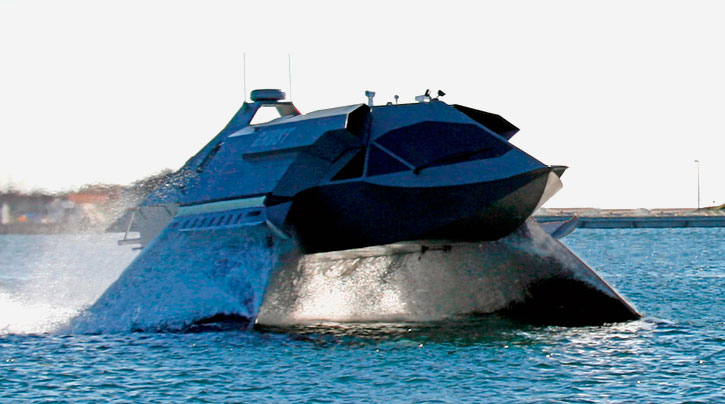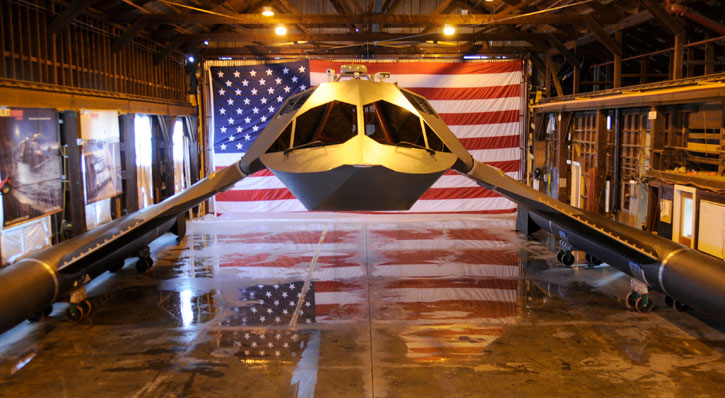BACKGROUND. The U.S. Navy is currently primarily a deep water Navy—ill equipped to deal with the shallower coastal waters known as the ‘Littoral Zone.’
Coastal (littoral) missions could include anti-piracy (which is all too common in deep water as well) coastal raids, fire support for special operators or Marines, countering the threat from small boats (as demonstrated by the Iranians and the attack on the USS Cole).
LITTORAL COMBAT SHIPS. To resolve this deficiency a class of relatively small, fast multi-purpose LCSs (Littoral Combat Ships) was proposed. Two variations are being evaluated.

Freedom Class from Lockheed Martin. c. 3,000 tons, 378 feet long. 47 knots. Cost c$700 million

Independence Class from General Dynamics and Austal c. 3,100 tons, 418 feet long, 44 knots. Cost $704 million first ship. $360 million future ships.
COSTLY. CONTENTIOUS & UNSUITABLE? The LCS program has been—and remains—contentious. There have been major technical problems—and serious questions have been raised about both the survivability of such ships and their firepower. In addition, it is clear that costs have spiraled out of control—in the classic manner of such projects (where the pattern is to secure the contract with a low bid which then escalates as the project proceeds).
A SUGGESTED ALTERNATIVE. The Super Ghost is being suggested as an alternative. It represents a dramatically different approach—and could be much cheaper. However, development is less far advanced and its technology unproven operationally.
THE GHOST

The hull—and all its associated drag—is out of the water. Two angled ‘skirt’s’ link it to propulsion tubes. Powerful engines in the tubes create the bubble and power the boat at high speed. Stated goal is 50 knots (I think it will go faster).

The supercavitation propulsion method used to speed up the Ghost is the same enabling the Russian Shkval torpedo to gain a speed four time higher than its western counterparts. Essentially, an air bubble surrounds the torpedo—or ships hull—or equivalent—thus vastly reducing friction. The principle is simple. Doing it is another matter.

This is a head on shot of The Ghost. Note the sharp leading edges of the ‘skirt’ that cut through the sea. The powerful engines are in the tubes. Minimal drag + supercavitation equates to speed plus fuel economy.
FAST, STEALTHY & INNOVATIVE. This is a fascinating project. It could herald a whole new approach to both ship design and propulsion. The ship is called ‘Ghost’ because it is both fast and stealthy—it doesn’t show up on radar.
Reportedly, thanks to the fact that it cuts through the waves plus a self-adjusting suspension, the Ghost is unusually stable.
How will the ship cope with high waves and adverse weather conditions? No information on these matters is available as yet. This, as yet, a development project.
Defense-update.com comments as follows.
Juliet Marine Systems a small company from Portsmouth, N.H., has developed a unique high-speed watercraft called Ghost that could take on missions close to shores, where larger vessels, such as the Littoral Combat Ship (LCS) would normally be too vulnerable to operate – company officials say. While initially the Ghost design was offered for fast patrol, special operations and force protection missions, Juliet Marine is now promoting a scaled-up corvette version ‘super Ghost’ for the US Navy re-evaluation of the Littoral Combat Ship force structure.
“With Ghost you can you can get into denied-access ocean areas, monitor what’s going on, launch operations and leave, and no one knows you’re there”
Plans are to build a corvette-sized 46 meter (150 ft) ‘super Ghost’ at a cost of about $50 million per vessel – six times cheaper than the $300 million per-ship cost of a current Freedom-class and Independence-class littoral combat ship. Such a vessel could operate with LCS or with other oceangoing naval vessels, providing a more affordable, agile and survivable naval strike forces.
No comments:
Post a Comment